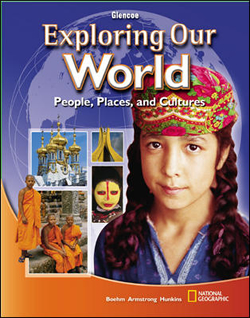
Exploring Our World: People, Places, and CulturesChapter 29: History and Cultures of Australia, Oceania, and AntarcticaChapter OverviewsAsian and Pacific peoples settled Australia, New Zealand, and Oceania thousands of years ago during an Ice Age. When ice melted and oceans rose, these people were cut off from the rest of the world. The people now called Aborigines in Australia were hunters and gatherers. Their religion emphasized relationship with nature. People settled in New Guinea and other islands in the Pacific about the same time, and the Maori left Polynesia to settle in New Zealand. They set up villages, grew crops, and fished. Captain James Cook claimed Australia for Great Britain in the 1700s, but England sent prisoners from overcrowded prisons to the island. Later, more British farmers settled and raised sheep for wool. As Europeans took more and more land from Aborigines, however, the Aborigines were forced to defend their land. By the late 1800s, war and disease had greatly decreased the population of Aborigines. Great Britain divided Australia into five separate colonies that made their own laws. Every man was allowed to vote, paving the way for democracy for the colonists. Similarly, British settlers arrived in New Zealand in the early 1800s, and the diseases they brought with them killed half the Maori population. The remaining Maori agreed to a treaty to keep their land but soon British settlers took it over, too, to raise sheep and cattle. As global trade grew, Europeans and Americans also colonized islands in Oceania. Australia, New Zealand, and many islands in Oceania gained independence in the 1900s. Australia and New Zealand are today parliamentary democracies. In 1893, New Zealand was the first country to grant women the right to vote; Australia followed in 1902. In the twentieth century, two world wars led to independence for many of the islands in Oceania. Japan had to turn them over to the United States as trust territories after World War II, but since the 1960s most have become independent. A few have had ethnic conflict since gaining their independence. Compared to other regions of the world, Australia, Oceania, and Antarctica are sparsely populated. But people from different parts of the world have helped shape the cultures of Australia, New Zealand, and Oceania. Most people in those countries live in coastal urban areas in Western-style apartments or small houses. People of European descent make up the primary ethnic groups in Australia and New Zealand. Australia has recently seen immigration increases from Asia, and the Aborigine population is also growing, so Australia is becoming more diverse. New Zealand is not as diverse. In contrast, most of the people in Oceania live in small rural villages. Three main ethnic groups—Melanesians, Polynesians, and Micronesians—make up most of the population. Together, the peoples of Oceania speak more than 1,200 languages. Daily life has been influenced by European and Pacific traditions in Australia and Oceania. People of European backgrounds tend to live in nuclear families, while the Aborigines, Maori, and Pacific Islanders stress extended families. Christianity is the most widely practiced religion, but in some areas traditional religions are still practiced. The arts in Australia draw from the Aborigine history as well as modern viewpoints. Much of New Zealand’s art is based on Maori culture. People in this region enjoy outdoor sports, especially water sports. |  |















